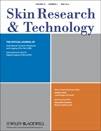Assessment of melanocytic skin lesions with a high-definition laser Doppler imaging system
Abstract
Background
Early detection is a major goal in the management of malignant melanoma. Besides clinical assessment many noninvasive technologies such as dermoscopy, digital dermoscopy and in vivo laser scanner microscopy are used as additional methods. Herein we tested a system to assess lesional perfusion as a tool for early melanoma detection.
Methods
Laser Doppler flow (FluxExplorer) and mole analyser (MA) score (FotoFinder) were applied to histologically verified melanocytic nevi (33) and malignant melanomas (12).
Results
Mean perfusion and MA scores were significantly increased in melanoma compared to nevi. However, applying an empirically determined threshold of 16% perfusion increase only 42% of the melanomas fulfilled the criterion of malignancy, whereas with the mole analyzer score 82% of the melanomas fulfilled the criterion of malignancy.
Conclusion
Laser Doppler imaging is a highly sensitive technology to assess skin and skin tumor perfusion in vivo. Although mean perfusion is higher in melanomas compared to nevi the high numbers of false negative results hamper the use of this technology for early melanoma detection.




